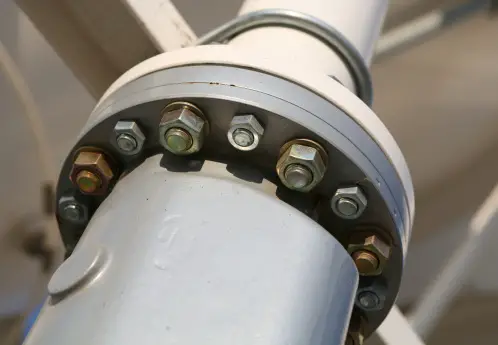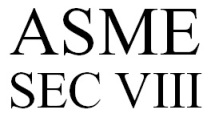In flange leakage analysis using ASME Section VIII method, you have come across two important factors for gaskets as input. They are gasket m factors and gasket y factors. In this article, we will learn about the importance of these two factors in piping stress analysis.
What is Gasket m Factor?
Gasket m factors are known as gasket factors. The value of m is dependent on the gasket material and construction. These gasket m factor values are used as a multiplier factor for determining the necessary compressive load on the gasket to maintain a seal when the pipe is pressurized. The gasket factor m is also known as the maintenance factor. m factor is dimensionless as the values of the gasket m factor are usually calculated as the ratio of the net pressure to the internal pressure. In Caesar II software, the gasket m factor is termed the leak pressure ratio.
This constant ensures that the flange has adequate strength and available bolt load to create good sealing without leakage. At the same time, the joint will withstand the effects of hydrostatic end force or internal pressure.
Importance of Gasket Factor m
The gasket factor m is used to calculate the required bolt load for a flanged joint to work properly during the operating condition. As per ASME BPVC Sec VIII, the required bolt load in operating condition is Wm1= H + Hp = 0.785G2P + (2b x 3.14GmP)
What is Gasket y Factor?
The gasket y factor is the minimum gasket or joint‐contact‐surface unit seating load. in Caesar II software, this gasket y factor is known as gasket seating stress and the values are provided in KPa, N/mm2, or lb/in2 unit. The gasket y-factor is also an important parameter for ASME flange stress calculations and is required as an input.
Importance of Gasket y Factor
The gasket y factor is required to calculate the initial bolt load required under atmospheric temperature conditions when no internal fluid pressure is acting. The gasket must be seated properly using this minimum initial load. The initial bolt load is calculated using the formula Wm2=3.14bGy
Here,
- G = diameter at the location of gasket load reaction
- b = effective gasket or joint‐contact‐surface seating width
- P = internal design pressure
Values of Gasket m and y Factors
The values of gasket m and y factors for some of the most common gasket materials and contact facings are available in Table 2-5.1 of ASME BPVC Sec VIII Div 1 code. However, note that the gasket m and y factor values are only suggested values that are proven to work satisfactorily in actual service and are not mandatory.
| Gasket Material | Gasket Factor (m) | Seating Stress, y (PSI) | Seating Stress, y (Kpa) |
| Self-energizing types (O rings, metallic elastomer, and other self-sealing types) | 0 | 0 | 0 |
| Elastomers without fabric or a high percent of asbestos fiber: | |||
| Below 75A shore durometer | 0.5 | 0 | 0 |
| 75A or higher shore durometer | 1 | 200 | 1,400 |
| Asbestos with a suitable binder | |||
| 1/8″ thick | 2 | 1,600 | 11,000 |
| 1/16″ thick | 2.75 | 3,700 | 26,000 |
| 1/32″ thick | 3.5 | 6,500 | 45,000 |
| Elastomers with cotton fabric | 1.25 | 400 | 2,800 |
| Elastomers with asbestos fabric | |||
| 3 ply | 2.25 | 2,200 | 15,000 |
| 2 ply | 2.5 | 2,900 | 20,000 |
| 1 ply | 2.75 | 3,700 | 26,000 |
| Vegetable fiber | 1.75 | 1,100 | 7,600 |
| Spiral-wound, asbestos-filled: | |||
| Carbon | 2.5 | 10,000 | 69,000 |
| Stainless, Monel, and nickel alloys | 3 | 10,000 | 69,000 |
| Corrugated metal, mineral fiber inserted, or corrugated metal, jacketed mineral fiber filled | |||
| Soft aluminum | 2.5 | 2,900 | 20,000 |
| Soft copper or brass | 2.75 | 3,700 | 26,000 |
| Iron or soft steel | 3 | 4,500 | 31,000 |
| Monel or 4%-6% chrome | 3.25 | 5,500 | 38,000 |
| Stainless steels and nickel alloys | 3.5 | 6,500 | 45,000 |
| Corrugated metal: | |||
| Soft aluminum | 2.75 | 3,700 | 26,000 |
| Soft copper or brass | 3 | 4,500 | 31,000 |
| Iron or soft steel | 3.25 | 5,500 | 38,000 |
| Monel or 4%-6% chrome | 3.5 | 6,500 | 45,000 |
| Stainless steels and nickel alloys | 3.75 | 7,600 | 52,000 |
| Flat metal, jacketed asbestos filled | |||
| Soft aluminum | 3.25 | 5,500 | 38,000 |
| Soft copper or brass | 3.5 | 6,500 | 45,000 |
| Iron or soft steel | 3.75 | 7,600 | 52,000 |
| Monel | 3.5 | 8,000 | 55,000 |
| 4%-6% chrome | 3.75 | 9,000 | 62,000 |
| Stainless steels and nickel alloys | 3.75 | 9,000 | 62,000 |
| Grooved metal | |||
| Soft aluminum | 3.25 | 5,500 | 38,000 |
| Soft copper or brass | 3.5 | 6,500 | 45,000 |
| iron or soft steel | 3.75 | 7,600 | 52,000 |
| Iron or 4%-6% chrome | 3.75 | 9,000 | 62,000 |
| Stainless steels and nickel alloys | 4.25 | 10,100 | 70,000 |
| Solid flat metal | |||
| Soft aluminum | 4 | 8,800 | 61,000 |
| Soft copper or brass | 4.75 | 13,000 | 90,000 |
| Iron or soft steel | 5.5 | 18,000 | 124,000 |
| Monel or 4%-6% chrome | 6 | 21,800 | 150,000 |
| Stainless steels and nickel alloys | 6.5 | 26,000 | 180,000 |
| Ring joint | |||
| Iron or soft steel | 5.5 | 18,000 | 124,000 |
| Monel or 4-6% chrome | 6 | 21,800 | 150,000 |
| Stainless steels and nickel-base alloys | 6.5 | 26,000 | 180,000 |









Ingeniero saludes desde colombia quiero mejorar mis conocimientos en tubería Piping soy qaqc Dios lo bendiga Ingeniero y en lo pueda enseñar o ser enseñado.